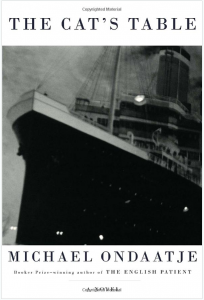 For much of the 20th century, long sea voyages were the only way to travel from one continent to another, and thousands of people made long trips. Four or six week long voyages were not uncommon (it took nearly a week to cross the Atlantic in the 1960s) and shipboard romances became the stuff of novels (and movies). In the early 1950s, at the age of about 11, Michael, the main character of Michael Ondaatje’s novel disguised as a memoir, was put on a steamship in Colombo, Ceylon (now Sri Lanka) for a voyage to his divorced his mother in Britain. Later, as an adult, Michael catches up with some of his former shipmates.
For much of the 20th century, long sea voyages were the only way to travel from one continent to another, and thousands of people made long trips. Four or six week long voyages were not uncommon (it took nearly a week to cross the Atlantic in the 1960s) and shipboard romances became the stuff of novels (and movies). In the early 1950s, at the age of about 11, Michael, the main character of Michael Ondaatje’s novel disguised as a memoir, was put on a steamship in Colombo, Ceylon (now Sri Lanka) for a voyage to his divorced his mother in Britain. Later, as an adult, Michael catches up with some of his former shipmates.
It’s hard to imagine now, putting a child on a ship for a three-week voyage. Michael quickly makes friends with two other boys about his age, also travelling alone. Together, they set about exploring the adult world, finding several unreliable guides from their companions at the cat’s table, located at the far end of the dining room, about as far from the social heights of the captain’s table as it was possible to be. As one of them, Miss Lasqueti, puts it, “We seem to be at the cat’s table . . . We’re in the least privileged place.” Mr. Nevil, a retired ship dismantler, doing safety research for the shipping line, teaches the boys how to move around the ship safely, introducing them to the engine room and the lifeboats. Mr. Mazappa, a musician on the skids, teaches them songs and provides other useful information. Michael’s roommate, in charge of the ship’s kennels, runs a nightly bridge game in their cabin. Mr. Daniels, a botanist, takes them to the ship’s hold, complete with a greenhouse full of specimens on their way to Europe. The boys sneak into First Class, and spy on a prisoner, on his way to Europe for trial, when he is brought out for walks late at night.
Michael’s recollections of his shipmates, the developing friendships between Michael and the other boys, and the care and concern the various adults extend toward him make for a lively and expressive story. Unfortunately, the last third or so of the book, when Michael becomes reacquainted with several of the ship’s passengers as an adult, is disappointing. It’s flat and unpersuasive, almost unrelated to what has come before; the foreshadowing is poor, and the two halves of the story seem disconnected. It’s as if Ondaatje grafted two ideas together, and thought of their relationship after the fact.
All the same, this is a book worth reading, because the beginning parts are so entertaining and interesting. If you can figure out how the last third or so relates, or if you think Ondaatje does a better job tying it all together than I think he does, let us know why in the comments.
Have a book you want me to know about? Email me at asbowie@gmail.com. I also blog about metrics here.
